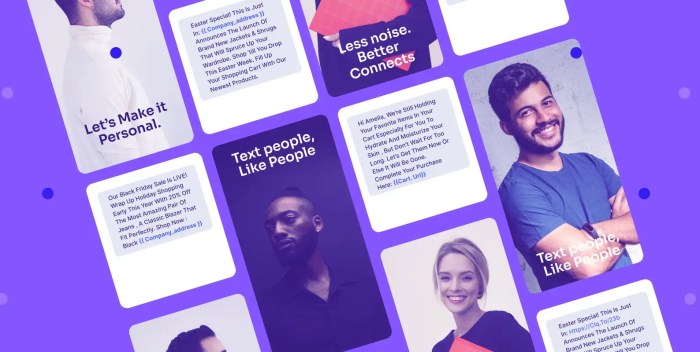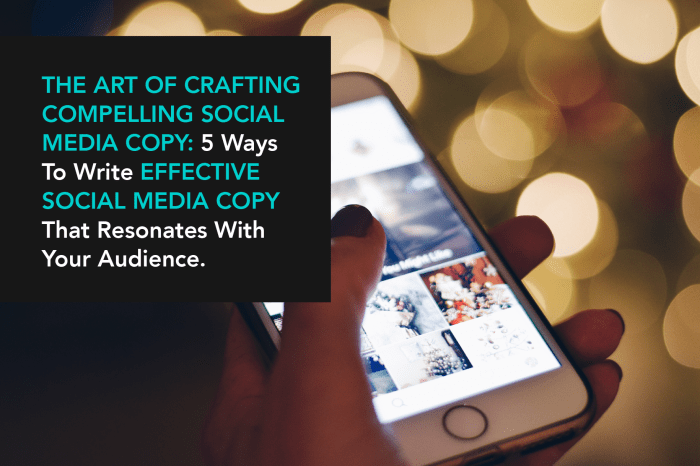Crafting Social Media Messages dives into the world of creating impactful online content that resonates with diverse audiences. From decoding the secrets of successful brands to unleashing the power of visuals, this guide is your ticket to digital marketing stardom.
Unleash your creativity and elevate your online presence with the ultimate guide to crafting compelling social media messages.
Crafting Social Media Messages
Crafting compelling social media messages is crucial for brands to engage with their audience, build brand awareness, and drive conversions. In today’s digital age, where attention spans are short and competition is fierce, the ability to create impactful messages that resonate with users is more important than ever.
Importance of Crafting Compelling Messages
Crafting compelling social media messages is essential to capture the attention of users scrolling through their feeds. By creating content that is engaging, relevant, and valuable to your target audience, you can increase brand visibility, drive traffic to your website, and ultimately, boost sales.
Hey, have you checked out the latest trends in Designing Visual Content ? It’s all about creating eye-catching graphics and engaging images that really pop on social media. Whether you’re into photography, graphic design, or just love playing around with filters, this article will give you some fresh ideas to step up your visual game. Get ready to unleash your creativity and make your content stand out!
- Use catchy headlines and captions to grab attention.
- Incorporate storytelling to create an emotional connection with your audience.
- Include a call-to-action to encourage user interaction and engagement.
- Utilize hashtags to increase visibility and reach a wider audience.
Examples of Successful Social Media Messages
- Nike’s “Just Do It” campaign resonates with their audience by promoting a message of empowerment and motivation.
- Wendy’s Twitter account is known for its witty and humorous responses, engaging users in a fun and relatable way.
- Coca-Cola’s “Share a Coke” campaign personalized their products by featuring names on the bottles, encouraging social sharing and user-generated content.
Tailoring Messages to Different Platforms
Each social media platform has its own unique audience and features, requiring tailored messages to effectively reach users. Consider the following tips when crafting messages for different platforms:
- Use visually appealing images on Instagram to showcase products or behind-the-scenes content.
- Create short and engaging videos on TikTok to capture the attention of a younger demographic.
- Share informative articles and industry news on LinkedIn to establish credibility and expertise.
- Utilize Twitter’s character limit to craft concise and impactful messages that drive conversation.
Role of Visuals and Multimedia
Visuals and multimedia play a crucial role in enhancing social media messages by making content more engaging and shareable. Incorporating images, videos, infographics, and GIFs can help capture the attention of users and convey information in a more digestible format.
Yo, have you checked out the latest trends in Designing Visual Content ? It’s all about creating eye-catching graphics and images that really pop! Whether you’re into digital marketing or just love being creative, this is the place to be. Get inspired and start designing like a boss!
Remember, the key to crafting successful social media messages lies in understanding your audience, being authentic, and consistently delivering valuable content that resonates with users.
Understanding Your Audience

When it comes to crafting social media messages, understanding your audience is key. By identifying key factors and analyzing your audience, you can create more effective messages that resonate with different segments. Feedback and insights from your audience can help refine your messages for better engagement.
Identifying Key Factors
- Demographics: Consider age, gender, location, income, and education level of your audience.
- Interests: Understand what topics, trends, and hobbies are relevant to your audience.
- Preferences: Take into account how your audience prefers to consume content, whether it’s through videos, images, or text.
Audience Analysis for Effective Messages
- Personalization: Tailor your messages to different audience segments based on their preferences and interests.
- Tone and Voice: Adjust the tone and voice of your messages to match the communication style of your audience.
- Timing: Consider the best times to post your messages to reach your audience when they are most active.
Engaging Different Audience Segments
- Create diverse content: Develop a mix of content types to appeal to different preferences within your audience.
- Use interactive elements: Encourage engagement through polls, quizzes, contests, and other interactive features.
- Listen and respond: Monitor comments, messages, and mentions to engage with your audience and build relationships.
Significance of Feedback and Insights
- Feedback loop: Use feedback from your audience to refine your messages, content strategy, and overall approach.
- Data-driven decisions: Analyze insights and metrics to understand what resonates with your audience and adjust your messaging accordingly.
- Continuous improvement: Regularly review feedback and insights to stay relevant and adapt to changing audience preferences.
Content Creation and Curation
Crafting engaging and relevant content is crucial for social media success. Whether creating original content or curating from external sources, the goal is to captivate your audience and drive interaction.
Creating Original Content
Creating original content involves brainstorming ideas, designing visuals, and writing compelling copy. This process allows brands to showcase their unique voice and perspective. Tools like Canva, Adobe Spark, and Piktochart can assist in creating eye-catching graphics. Resources such as Grammarly and Hemingway App help ensure the content is clear and error-free.
Curating Content from External Sources
Curating content involves finding and sharing relevant posts, articles, or videos from other sources. This can help save time and provide diverse perspectives to your audience. Platforms like Feedly, Pocket, and BuzzSumo are useful for discovering and organizing curated content. Remember to always give credit to the original creators when sharing curated content.
Balancing Original and Curated Content
Maintaining a balance between original and curated content is key. Aim to have a mix of both to keep your feed fresh and engaging. A good rule of thumb is the 80/20 rule – 80% original content and 20% curated content. This ensures your brand’s voice is heard while also providing valuable information from external sources.
Writing Engaging Copy: Crafting Social Media Messages

When it comes to crafting social media messages, writing engaging copy is key to capturing your audience’s attention and driving interaction. Persuasive copywriting involves using language and tone that motivates users to take action, whether it’s liking a post, sharing content, or making a purchase. Here are some tips to help you create concise yet impactful copy that resonates with your audience:
Elements of Persuasive Copywriting, Crafting Social Media Messages
- Use compelling language: Choose words that evoke emotion and urgency to prompt action.
- Create a sense of exclusivity: Make users feel like they are part of an exclusive group or offer to drive engagement.
- Highlight benefits: Clearly communicate the benefits of your product or service to entice users to learn more.
Tips for Writing Concise Copy
- Keep it short and sweet: Get to the point quickly and avoid unnecessary fluff.
- Use bullet points or lists: Break up information into digestible chunks for easy reading.
- Include a clear call-to-action: Prompt users to take the next step, whether it’s visiting a website, signing up for a newsletter, or making a purchase.
Examples of Calls-to-Action
- “Shop now and get 20% off your first purchase!”
- “Sign up for our newsletter to receive exclusive deals and updates!”
- “Don’t miss out – RSVP to our event today!”
Importance of A/B Testing Copy
- A/B testing copy variations allows you to see which messaging resonates best with your audience.
- By testing different wording, calls-to-action, and tones, you can optimize your message performance and drive better engagement.
- Regularly testing and analyzing results will help you refine your copywriting strategies for maximum impact.